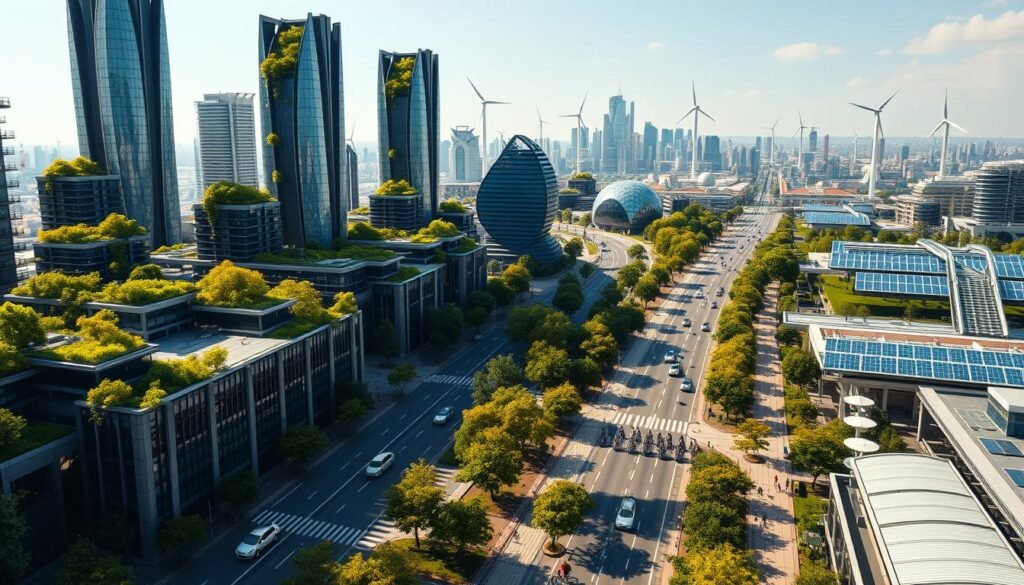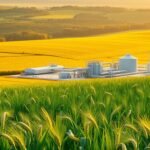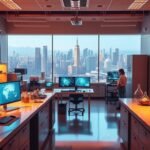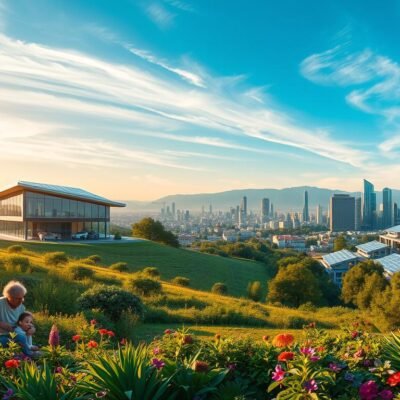A staggering 68% of the world’s population is set to live in cities by 2050. This shows how urgent it is for sustainable urban development. It’s key to making cities better for people and the planet.
Sustainable urban development is vital for cities that are good for the environment and people. Eco-friendly cities aim to lessen their environmental impact. They also focus on economic growth and fairness for all.
By using sustainable practices, cities can cut down on pollution. They can also improve the air and water and create green spaces. These spaces are good for both people and animals.
Introduction to Sustainable Urban Development
Sustainable urban development looks at the social, economic, and environmental sides of city planning. It aims to make cities strong, flexible, and meet the needs of their people. By focusing on sustainability, cities can build a brighter future for themselves and future generations.
Key Takeaways
- Sustainable urban development is crucial for creating eco-friendly cities
- 68% of the world’s population will live in urban areas by 2050
- Sustainable urban development prioritizes the well-being of residents and the environment
- Eco-friendly cities promote economic growth and social equity
- Sustainable urban development involves creating resilient and adaptable cities
- Sustainable urban development is essential for reducing carbon footprint and improving air and water quality
Understanding Sustainable Urban Development
Sustainable urban development is a big topic now. It’s because more people are moving to cities. We need cities that are good for the environment and offer a great life for everyone. Urban planning is key to making this happen. It helps cities grow in a way that’s good for the planet.
By using green infrastructure in planning, cities can be better for the environment. This also makes people healthier and happier. Let’s look at some benefits of sustainable cities:
- Green spaces help clean the air and improve health
- Energy-saving buildings use less power
- Good public transport cuts down on car use
By following these steps, cities can be better for now and the future. As more people move to cities, it’s vital to focus on urban planning and green infrastructure. This way, cities can be both sustainable and lively.
Historical Context of Urban Development
Understanding the history of city growth is key to shaping our future cities. The idea of sustainable design has been around for ages. Ancient cities had green spaces and smart water systems. As cities grew, so did the focus on urban regeneration, making cities better for everyone.
The history of city planning has seen big changes. The Industrial Revolution led to fast city growth, needing new ways to manage it. Here are some examples of sustainable design in old cities:
- Ancient Rome’s aqueducts and public baths showed a dedication to clean water and sanitation.
- Medieval European cities had narrow streets and tight buildings. This helped reduce travel time and encouraged walking.
- Today, cities like Copenhagen use green roofs, bike paths, and district heating to cut down on pollution.
These examples show that sustainable design and urban regeneration are ongoing efforts. By learning from the past, we can make cities better. We aim for cities that are strong, green, and fair for everyone.
The Role of Green Spaces
Green spaces are key in sustainable architecture for cities. They offer many benefits to city dwellers. They help cool cities, clean the air, and support local wildlife.
In smart cities, these areas do more than just look good. They serve as parks, gardens, and even roofs covered in plants.
Green spaces in cities bring many advantages. They improve air quality, boost mental health, and encourage people to be active. They also help local animals and plants thrive.
- Improved air quality
- Enhanced mental health and well-being
- Increased opportunities for physical activity
- Support for local wildlife and ecosystems
Mixing nature into city planning is vital. It makes cities better places to live. This can be done with green spaces like parks, roofs, and walls.

In smart cities, green areas are high-tech. They have smart watering systems and energy-saving lights. This reduces harm to the environment and supports sustainable architecture and eco-friendly living.
Transportation Solutions for Sustainable Cities
Cities are growing fast, and we need to find ways to make transportation greener. We can do this by improving public transit, promoting walking and biking, and setting up electric vehicle charging stations.
Here are some ways to make transportation greener:
- Start efficient public transit like bus rapid transit and light rail
- Make cities bike-friendly with bike lanes and bike-share programs
- Give incentives for electric and hybrid vehicles and build more charging stations
By using these methods, cities can cut down on pollution, make the air cleaner, and make life better for everyone. Sustainable urban development means creating cities that are good for the planet and for people.
Studies show that cities focusing on green transportation and sustainable development grow faster, have healthier people, and happier citizens. By putting these efforts first, cities can build a brighter future for all.
Energy Efficiency in Urban Design
Cities are growing fast, and we must focus on energy efficiency. We need to make eco-friendly cities through smart urban planning. This can greatly cut down on carbon emissions in cities.
By using green buildings and renewable energy, cities can lessen their harm to the environment. This makes cities healthier and more enjoyable for everyone living there.
Here are some ways to make cities more energy-efficient:
- Implementing green building codes and standards
- Investing in renewable energy sources, such as solar and wind power
- Optimizing energy efficiency in buildings through smart grid systems and energy-efficient appliances
Using these methods, cities can use less fossil fuel and emit fewer greenhouse gases. This helps fight climate change and improves air and health. It’s vital for cities to focus on energy efficiency and become eco-friendly through new urban planning ideas.
Energy efficiency is key to making cities sustainable and livable. By focusing on eco-friendly cities and smart urban planning, we can ensure a brighter future for all.
Community Engagement and Participation
Getting people involved in city planning is key for a greener future. When local folks help shape the plans, cities can build green spaces that everyone wants. This way, the city is good for the planet and the people living there feel like they own it.
Green spaces like parks and rooftops can be made to fit what a community needs. For instance, a community might want places for fun and meeting friends. By listening to what people say, cities can make spaces that are both useful and look great.
Some ways to get people involved include:
- Public meetings and workshops
- Online surveys and feedback mechanisms
- Collaborative planning sessions with community groups
These methods help cities hear what people want. This way, the city grows in a way that benefits everyone and the planet.
By using green spaces and smart design, cities can be kinder to the earth. As cities grow, it’s vital to keep involving people in planning. This ensures that the city works well for both its residents and the environment.
The Economic Impact of Sustainability
Cities are growing fast, and sustainability’s economic role is key. Urban renewal and smart cities help make cities better and more prosperous. By supporting green industries and practices, cities can offer new jobs and boost local economies.
Urban renewal and smart cities bring many benefits. For instance, green spaces can make properties more valuable. Also, energy-efficient buildings cut down on energy costs and improve air quality. Smart cities attract businesses, which helps the economy.
- Job creation in green industries, such as renewable energy and sustainable construction
- Long-term cost savings through energy efficiency and reduced waste
- Increased property values and local economic growth
By focusing on sustainability, cities can have a positive economic effect. They also improve life for their people. As cities grow, it’s crucial to think about sustainability’s economic benefits. We need to find ways to make cities sustainable and prosperous.
Climate Resilience in Urban Areas
Cities are facing big challenges from climate change. They deal with rising temperatures, more natural disasters, and changing weather. To tackle these issues, cities need to focus on being climate resilient. They should use sustainable architecture and green transportation to lessen their environmental footprint and get better at handling climate stresses.
Adapting to climate change involves several steps. One is using green infrastructure like parks and green roofs to fight the urban heat island effect and handle stormwater. Cities can also encourage green transportation like electric cars, biking, and walking. This helps cut down air pollution and lessens dependence on fossil fuels.
Cities like Copenhagen are leading the way. They’ve put a lot into sustainable architecture and green transportation. They have a wide bike lane network and aim to be carbon neutral by 2025. Rotterdam, on the other hand, has come up with creative solutions like floating homes and sea walls to fight rising sea levels and extreme weather.
By focusing on climate resilience and using sustainable architecture and green transportation, cities can become less vulnerable to climate risks. This makes them healthier and more sustainable places for everyone.
Technology’s Role in Sustainable Development
As cities grow, technology is key in shaping their future. It helps make cities greener and better for people. This is important for cities to thrive and be good for the planet and people.
Eco-friendly cities focus on people and the planet. They use green tech like solar power and green roofs. Technology also makes cities better by improving how we move around and manage waste.

- Green spaces like parks help cool cities and clean the air
- Energy-saving buildings cut down on energy use and pollution
- Smart transport systems encourage using public transport and biking
By using these technologies, cities can be greener and better for everyone. They offer a great life for residents while protecting the environment.
Policy Frameworks Supporting Sustainability
Effective urban planning is key for sustainable cities. Local governments are vital in setting policies for sustainable growth. They can make cities greener and better for people by using green infrastructure.
Some important steps include:
- Setting green building codes to cut down energy use
- Building public transport to lessen car use
- Creating parks to fight the urban heat island effect
Federal policies also play a big role. Governments can offer money and support for green practices. This can be through backing renewable energy and energy-saving tech.
Local and federal governments can work together. This way, they can make policies that help cities grow sustainably. Using urban planning and green infrastructure is crucial for a greener future.
Future Trends in Urban Development
Cities are changing, and the future looks bright. Sustainable design and urban regeneration will lead the way. They will make our cities better, greener, and more vibrant.
Smart city tech will soon be everywhere. We’ll see more renewable energy, better waste management, and smart traffic. Mixed-use areas will mix homes, shops, and parks, making cities easier to get around.
Urban farming will grow, with more rooftop gardens and vertical farms. Buildings will use green materials and save energy. This will help our planet.








